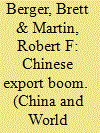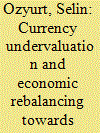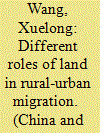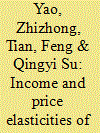| Srl | Item |
| 1 |
ID:
119150


|
|
|
|
|
| Publication |
2013.
|
| Summary/Abstract |
This paper discusses China's relatively new structure of dual onshore and offshore RMB markets. Its distinguishing feature is both offshore trading at exchange rates that are market determined and onshore trading at exchange rates anchored at the official spot rate with capital account inconvertibility. We note that thus far the CNH and CNY spot rates have largely tracked each other, suggesting that the shadow price on the convertibility constraint onshore and also the offshore diversification benefit is close to zero. However, this could change in the future. We discuss the potential for the offshore RMB market to grow with trade settlement and bilateral swap arrangements in RMB, which would provide a big enough pool of liquidity for the RMB to become a vehicle currency and reserve currency. These potential developments will be restrained by onshore inconvertibility, but moving to convertibility seemingly implies major change in China's financial structure and the offshore RMB arrangements are only a small first step along this path. Crucial in this evolution of arrangements will be future Chinese growth performance and the relative attractiveness of onshore inconvertible but offshore marketable RMB relative to the debt laden and slow growth currencies of the USA, the EU and Japan.
|
|
|
|
|
|
|
|
|
|
|
|
|
|
|
|
| 2 |
ID:
119152


|
|
|
|
|
| Publication |
2013.
|
| Summary/Abstract |
From 2000 to 2007, Chinese exports grew at a phenomenal pace. Our paper uses finely detailed Chinese export data (8-digit Harmonized Commodity Description and Coding System codes) combined with US trade data to explore how this was achieved. Although general explanations such as China's exchange rate policy no doubt played a role, we find that sector-specific stories, effective Chinese industrial policy and fortuitous timing were more critical. The detailed trade data reveal that "new" technology goods, such as cell phones, LCD screens and laptops, played a key role. Finally, we use the data to examine the relationship between Chinese exports and global manufacturing, in particular US manufacturing employment. We find that competition from China in both domestic and foreign markets likely contributed to a significant decline in USA manufacturing employment, but that relatively low US investment and slow GDP growth in the US following the 2001 recession played an equally important role.
|
|
|
|
|
|
|
|
|
|
|
|
|
|
|
|
| 3 |
ID:
119151


|
|
|
|
|
| Publication |
2013.
|
| Summary/Abstract |
The present study investigates the main determinants of the employment share of the service sector using a panel of 66 countries over the period 1983-2007. Based on alternative measures of currency misalignment, the study extends the literature by investigating the impact of an undervalued currency on services. The empirical findings show that together with productivity and income per capita, currency undervaluation significantly determines the total employment share of services. Another key finding is that conventional crosscountry determinants and the exchange rate undervaluation can only partially explain the underdevelopment of services activity in China and in other South-East Asian countries. In these countries, policies that aim at rebalancing the economy towards services should include elements to reform the domestic financial market, and the social security and healthcare systems.
|
|
|
|
|
|
|
|
|
|
|
|
|
|
|
|
| 4 |
ID:
119154


|
|
|
|
|
| Publication |
2013.
|
| Summary/Abstract |
This paper explores the influence of land holding on rural-urban migration using China's 2008 household survey data. It shows that the contradictory findings of existing published literature can be explained by introducing a migration distance variable. The empirical studies show that land holding plays a different role in short-distance and long-distance migration. Land holding has a U-shaped curve association with the probability of short-distance migration and has an inverted-U-shaped association with the probability of long-distance migration. Therefore, the government needs to provide more job information and migration subsidies to farmers who have little land to overcome difficulties in the process of migration so as to reduce rural-urban inequality.
|
|
|
|
|
|
|
|
|
|
|
|
|
|
|
|
| 5 |
ID:
119153


|
|
|
|
|
| Publication |
2013.
|
| Summary/Abstract |
The appearance of new product varieties and improvements in the quality of goods have both played key roles in the rapid growth of China's exports. However, these two important elements have not been formally integrated into the demand equations for China's exports. As we demonstrate in this paper, income elasticity will be underestimated if new varieties of goods and quality improvements are omitted in price index and quantity index calculations, which are necessary for estimating the export demand function. Moreover, the faster new product varieties enter export markets, the greater the underestimation will be. In this paper, we develop an export demand equation that takes into account new product varieties and improvements in quality, and then calculate the demand function for China's exports using the data from 1992 to 2006. According to our estimation, the short-term income elasticity of demand for China's exports is approximately 2.34, and the short-term price elasticity is approximately -0.65. Our estimation predicts an increase in China's export value in the case of an RMB appreciation or export rebate rates reduction in the short term, due to the low price elasticity of China's exports, whose absolute value is less than 1. Our findings are novel and could have significant policy implications.
|
|
|
|
|
|
|
|
|
|
|
|
|
|
|
|
| 6 |
ID:
119148


|
|
|
|
|
| Publication |
2013.
|
| Summary/Abstract |
International financial adjustment is the process whereby valuation shifts from asset price and currency changes result in relatively durable net wealth transfers across countries' international balance sheets. This paper applies a financial valuation approach to estimate the direction and the broad extent of recent international financial adjustments on China's international balance sheet. We estimate China's international balance sheet losses resulting from the valuation shifts over the period 2005-2010 and reveal that international currency shifts over the past decade have also generated a range of non-balance sheet financial and monetary adjustment pressures for China. This paper also evaluates how China's evolving international financial policy arrangements could better mitigate China's exposure to international financial adjustments. These arrangements include a more effective currency mechanism and the mechanisms to internationalize the RMB to buffer international financial valuation shocks.
|
|
|
|
|
|
|
|
|
|
|
|
|
|
|
|